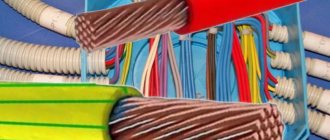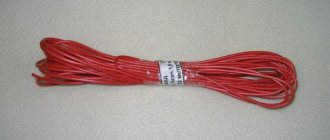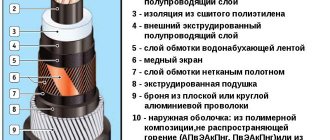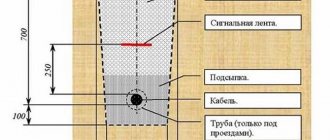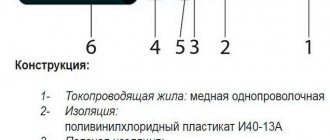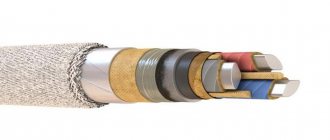The technical characteristics, as well as the price-quality ratio, that VVG wire has, allow it to compete on equal terms not only with domestic, but also with foreign analogues. Considering the number of varieties of this cable on the market, its scope of application is practically unlimited. The main thing is to choose the right section.
Scope of application
VVG brand wire is intended for use in household and industrial electrical circuits with voltages up to 1000 Volts. Most often, such a wire is recommended for home electrical wiring when using hidden and open installation methods, as well as when installing behind plasterboard floors.
The limitation on the use of VVG cable is its installation underground, since soft outer insulation will not be able to protect the wire from rodents or mechanical damage that may occur due to soil displacements. If it is necessary to use it for laying underground communications, the cable should be laid in a pipe or other rigid insulation.
Decoding abbreviations and modifications
The abbreviation, which is applied to the outer surface of the cable's insulating sheath, denotes its design features and technical characteristics. The sequence of letters and numbers carries certain information. The first capital letters VVG indicate the following:
- B - the material from which the insulation of the current-carrying conductors under the outer sheath is made, in this case it is polyvinyl chloride. The letter "B" comes from the name of the main component of the vinyl insulating layer material;
- B is the outer shell material, the main composition of which is also vinyl. Such insulation is usually called PVC, it is a thermoplastic. 43% of its composition is a petrochemical product, ethylene and 57% combined chlorine. The compositions of plastic insulation may differ; some models use a PVC shell with impurities that block the spread of fire.
- G - indicates that the general sheath of the current-carrying wires does not have an armored layer; such a cable is called bare, which does not have protection from harsh mechanical influences.
All models have copper wires with a rigid monolithic or flexible multi-core structure.
There are a number of modifications of plastic insulation:
- VVGpng - in this version, the added letter designation “png” indicates that it can be laid as part of a group of cables of other brands. Its outer shell does not propagate combustion. (png – flat non-flammable)
- VVGng–ls means that the composition of the plastic insulation contains impurities that, during combustion, reduce the release of toxic gases and smoke;
- VVGng-hf, in case of strong fire in the environment and high temperature, the insulating layer burns out and does not emit corrosive gases;
- VVGng-fr indicates the presence of a mica tape in the insulating layer, which creates a thermal barrier between the environment and the current-carrying conductors.
If there are no such markings, they spread the combustion of the insulation; this is a regular VVG.
The marking of the VVG cable in the digital abbreviation designation indicates the number and cross-section of the current-carrying conductors.
Power cable VVG APG 3x2.5+1 in this version VVG, the labeling shows:
- PNG - flat, non-flammable;
- 3 – number of conductive cores;
- 2.5 – cross-sectional area of wires;
- +1 – additional ground wire in the cable.
For laying under plaster, it is most often convenient to use VVG wire of a flat design; it fits compactly into the grooves and is easily plastered without protruding on the surface.
Fire safety markings
A complete description of the cable properties can be compiled using the main and additional markings. For VVG cable, decoding begins with the presence or absence of the letter “A” at its beginning. If it is not there, then the cable is copper, otherwise it is aluminum. The letters “B” indicate the insulation material: on the cores and on the outside - in both cases polyvinyl chloride is used. The last letter “G” indicates the absence of an external armored coating - such a cable, with a soft sheath, is considered bare. The letter “p”, if it appears after the letters VVG, means that the cable is flat - the cores in it are laid in a row, and not twisted together. There are also the designations “T” and “UHL”, which indicate tropical insulation performance or designed for temperate and cold climates.
In addition to the main letters, the cable marking may contain additional ones, indicating that the fireproof properties of the insulation differ from the standard ones.
- ng - shows that if wires are laid in one cable channel, if one of the wires is significantly overheated, the insulation will not ignite, but will only smolder, protecting adjacent wires from ignition;
- ng-ls – insulation when smoldering releases a reduced amount of smoke and carbon monoxide into the air;
- ng-hf - even if the insulation catches fire, a minimal amount of harmful resins and gases will be released into the air, which can have a corrosive effect;
- if the prefix “fr” is added to the listed designations, this indicates the fire resistance of the insulation, which is achieved by using mica-containing windings.
Wires can be numbered or color-coded, and manufacturers use complete painting of the wire core and partial painting - when only part of the insulation is colored, usually a strip 1 mm wide. If there are two current-carrying wires, then their color necessarily includes a blue neutral wire, and if there are three or more, then a yellow-green ground wire.
Explanation of the VVG cable abbreviation
Let's start our conversation about this type of cable by deciphering the abbreviation of its name. After all, the name alone can already say a lot about the structure and scope of application of this conductor.
Decoding the abbreviation VVG
- In the marking of any wires and cables, the first letter may be “A” . It says that the cable is made of aluminum. If it is not there, as in our case, then this indicates that the cable is made of copper.
- The first letter “B” tells us about the conductor insulation material. In our case, this is polyvinyl chloride or, as it is sometimes called, vinyl.
- The second letter is again “B” . It tells us that the cable, in addition to direct insulation, also has an additional sheath. As you might guess, it is also made of vinyl.
- The letter “G” tells us that the cable does not have a protective sheath or, as it is also called, armor. Thanks to this, the product is more flexible and has less weight. Although this reduces protection from mechanical damage.
VVGz cables
- In addition to these basic abbreviation letters, you may find additional symbols at the end. Therefore, so that they do not confuse you, let’s talk about them too. The first of them is “z”. This letter indicates that the space between the sheath and the cores is filled. Typically, threads made from the same polyvinyl chloride or other non-hydrophobic synthetic fiber are used for this.
- You may also come across the abbreviation “ozh”. It tells us that the cable is made of a single-wire core. Now we will not go into details, but will cover this issue in the description of the cable structure.
VVGp cables
- VVG cable and deciphering its name may confuse you if you see the letter “p” at the end. But there is nothing scary here, this abbreviation refers to the flat shape of the cable structure.
- In addition, you may come across the symbol "T" , which indicates a tropical cable design. Well, the abbreviation “ng” tells us about the degree of non-flammability of the cable. Usually after “ng” there are other symbols that reveal this property to us in more detail.
Explanation and scope of application of VVGng cables
Note! Additionally, after “ng” the conductor’s non-flammability class may be indicated. It is designated by the symbols "A" to "D". The higher the order of the letter, the higher the non-flammability class. In addition, the abbreviation may contain symbols indicating the release of cable combustion products. For example, “LS” indicates low smoke emission, and “LT” indicates low toxicity of gases released during combustion. Other combinations are possible.
Marking the number, location and shape of cores
After the letter designations, the cable marking contains numbers indicating the number of current-carrying wires and their number, for example - 3 x 25 means that the cable has 3 separate wires, each of which has a cross-section of 25 mm².
Four-core cables have their own peculiarity - some of their varieties are made with one core of reduced cross-section. This is due to the fact that the neutral or ground wire does not always need the same cross-section as the phase wires, and with its reduction when installing large electrical networks, the savings become significant. Accordingly, the use of a conductor with a smaller cross-section is reflected in the marking. If a standard four-core cable is designated 4 x 2.5 mm², then the marking with one reduced core will look like 3 x 2.5 + 1 x 1.5. This indicates that the cable contains three 2.5 mm² and one 1.5 mm² cores.
The next characteristic displayed in the marking is the use of single-wire or multi-wire conductors in the cable, for which the designations “O” - rigid or “M” - flexible wire are used. Their shape is also indicated, which can be round or sectoral - “K” or “C”, respectively.
The full marking looks like VVG 3 x 2.5 ms + 1 x 1.5 ms(N) – 0.66 TU – how it can be deciphered, in the table in the figure:
Markings indicating single or multi-wire conductors, as well as their shape, may not be applied if conductors of equal cross-section with an area of less than 16 mm² are used
Characteristics of VVG cable
All characteristics of any cable can be divided into mechanical and electrical. Both of these parameters are important for us, so let's look at each of them in more detail.
Mechanical characteristics of VVG cable
Let's start our conversation with mechanical characteristics. By this parameter we mean the cable’s resistance to mechanical, temperature and chemical influences.
Cable bending diameter according to GOST
- The first in the list of properties will be the radius of curvature of the cable. It depends on the type of cores from which the cable is made, and gives an idea of how much the cable can be bent during installation. According to GOST, for single-core cables this parameter is 10 cable diameters, and for multi-core cables it is 7.5 diameters. You can learn more about the features of this parameter in the video.
- The next important parameter is temperature conditions. For example, let’s take the VVG 3×1.5 power cable. Its normal operating conditions are temperatures from -50⁰С to +50⁰С. This is normal for any vinyl insulated cables or wires.
The photo shows the characteristics of the VVG cable
- At the same time, such a cable can only be installed at a product temperature of at least 15⁰C. If installation is intended at lower temperatures, the cable is preheated. If you do the installation yourself, then warming up is best done by connecting an appropriate load to the cable.
- But in emergency modes, VVG cables must normally withstand higher temperatures. So temperatures up to +70⁰С are considered normal. And periodically, during short circuit currents, the cable must withstand temperatures up to +160⁰C.
VVG cable manufacturer certificate
- Also, the certificate of conformity must confirm the cable’s ability to operate at relative humidity up to 98%. And this is at a temperature of 35⁰C. Products designed for tropical climates must be resistant to the formation of fungi.
Other mechanical characteristics of VVG cables
- In addition to the above, there are other mechanical characteristics of VVG cables. For example, tensile strength, elongation at break, requirements for aging of insulation and reducing its mass, but such parameters are unlikely to be of interest to non-professionals. Therefore, we will not consider them in our review.
Electrical characteristics of VVG cable
But be that as it may, a cable is, first of all, a conductor. Therefore, electrical parameters are no less important than mechanical ones. It is to them that we will give our attention finally.
VVG cable core resistance
- One of the main electrical parameters is wire resistance. This indicator depends on the type of core and its cross-section. For example, a VVG 3×1.5 power cable with a single-core wire will have a resistance of no more than 12.1 Ohm/km. And a cable with a cross-section of 35 mm2 has a resistance of no more than 0.524 Ohm/km.
Note! These figures are given for a core temperature of 20⁰C. As the temperature changes, the resistance also changes, so when taking measurements at other temperatures, correction factors should be used.
Electrical insulation resistance of VVG cable
- The next important parameter is the insulation resistance of the wire. It also depends on the temperature and cross-section of the wire. So for a wire with a cross-section of up to 1.5 mm2, the insulation resistance must be at least 12 MOhm. And for cables with a cross-section above 10 mm2 it should be at least 7 MOhm.
- The wire must also have a certificate that it has passed electrical tests. They are carried out with alternating current with a frequency of 50 Hz. VVG cables for voltages up to 660V must withstand a voltage of 3 kV for 10 minutes. A cable for voltages up to 1 kV must withstand a voltage of 3.5 kV at the same time.
Specifications
Where and how a specific brand of cable can be used is shown by its technical characteristics. VVG electrical wire has several varieties, of which the most commonly used cable is the VVGng brand, the technical characteristics of which are suitable for single and heap installation.
- The maximum voltage is 660-1000 Volts, depending on the insulation class.
- Recommended temperature of use is from -50 to +50 C°.
- Use is allowed at air humidity up to 98%.
- The temperature that insulation can withstand for a long time without changing its properties is 70 C°. It can withstand heating up to 90 C° for a short time and up to 250 C° for about 4 seconds. Insulation ignites at temperatures of +400 and above.
- Emergency operation is allowed for 8 hours a day, but not more than a thousand hours over the entire life of the wire.
- The permissible bending radius during installation depends on the type of core - solid or stranded. In the first case, the bend will be the total cable diameter * 10, and in the second - diameter * 7.5.
- The amount of wire in the bay depends on the cross-section of the cores. Up to 16 mm² - 450 meters, from 25 to 70 mm² - 300 meters, and all others - 200 m.
- The estimated service life of the wire is 30 years, the warranty period is 5 years.
The given data shows what VVGng cable is and where it can be used.
For more information about the VVG cable and its use, watch this video:
Cable subtypes
Already in the abbreviation VVG there are additional letters: VVGng, VVGngHF, VVGpng and others. Each option has additional characteristics and can be used in certain situations.
Source nag.ru
The difference between VVGng and VVGngLS is easy to decipher by their names:
- The VVG cable is distinguished by the presence of PVC insulation, which does not have any additives. When laying one cable, combustion does not spread. It is not recommended to lay several cables together, the exception is if each wire is in a separate corrugation.
- VVG-png is a flat power wire with 2-3 cores. Its PVC shell and insulation are low flammable. The cable is used in stationary electrical devices.
- VVGng is translated as “non-flammable”. The insulation contains special additives, thanks to which combustion does not spread through the wire even if several cables lie nearby.
- It is important to note the following: if the cable is on fire, it will still burn. If you pull it out of the flame, it will immediately go out.
- VVGngLS translates as “low smoke” or “low smoke level”. This is an important characteristic. When PVC burns, it releases dangerous toxic substances and produces a lot of smoke. If a large number of cables start to burn at once during a fire (for example, if a bundle is laid), you can suffocate in a few minutes. Compared to VVGng, VVGngLS wires burn poorly and emit almost no smoke and gas.
Source kafael.kz
- The differences between VVGng and VVGngLS do not end there. The VVGngLS cable has a subtype VVGngLSLTx. This cable has low gas and smoke emissions and is practically non-toxic.
- There is another type of cable - VVGngFRLS or “fire resistant, low smoke”. This option is distinguished by special insulation - mica-containing tape. Thanks to it, the cable remains operational for a long time (up to 3 hours) even with an open fire; when burning, it emits little smoke and is practically non-toxic. VVGngFRLS is used in places where fire safety requirements are very high, for example, in fire extinguishing or smoke removal systems, for fire alarm systems. It is rarely used in residential buildings due to its high price.
What is better not to use
Also on sale you can find NYM cable or Russian analogs NUM, NUM. This is a European version, which differs from VVG in several ways:
- The cores inside the wire are placed in chalk-filled rubber. This allows you to literally tear the cable with your hands, without using special tools.
- The outer shell of NYM is more sensitive to UV radiation. It is not recommended to lay the cable in the sun.
- NYM service life is 40 years.
- This cable burns better than VVG; it cannot be laid in bundles unless each wire is in a separate corrugation.
Source yandex.net
When understanding the difference between VVGng and VVG-png and other options, it is worth remembering that there are other cables. Each of them has its own characteristics. The PVS cable can only be used for a non-stationary connection, for example, as a cord in an extension cord. It is not suitable for fixed wiring. The SHVVP wire is intended only for lamps and sconces. It is completely prohibited to manufacture PUNP wire in Russia. Due to low insulation and greatly undersized cable cross-sections, the cable caused a huge number of fires.
A detailed comparison of different types of cables is shown in this video:
What to look for when choosing
Despite the difficulty of counterfeiting electrical cables, it is still possible to come across low-quality products in which the insulation does not meet the standards or the cross-section of the conductors is less than that indicated on the marking. To check the insulation, just look for the presence or absence of drips - a good wire will have a clean, even cut with the insulation of a tight-fitting core. To check the cross-section, you can use a micrometer or the “old-fashioned” method, when the core is folded into 10 layers and measured with a ruler. For the rest, you need to focus on the calculated indicators and select a cable of the required cross-section.
Which cable is better for electrical wiring: flat or round?
It is impossible to say unequivocally which electrical cable is better for wiring. The use of a certain option is related to the installation and operating conditions of the product. For example, when laying power trunk lines with an alternating voltage of 400 V in residential buildings and industrial buildings (in special cable niches, cable ducts, boxes and hidden wiring under the floor or ceiling), a round cable is used, since it has the required number of cores and a wide variety of cross-section options. This cable can also be used for electrical wiring in premises; it is conveniently pulled into cable corrugations and can be laid in them with open wiring.
But for indoor electrical wiring, flat cables are often used. This is due to the convenience of installing such a cable product in grooves in various structures (concrete, brick, etc.) and the fact that such a cable does not take up much space in cable ducts and can be hidden behind a layer of finishing materials (plaster or drywall). But using corrugations with a cable is more difficult, since it requires a larger cross-section of the protective tube and effort when pulling the cable into the corrugation.


